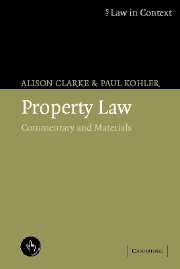Book contents
- Frontmatter
- Contents
- Preface
- Acknowledgments
- Table of cases
- Table of statutes
- Table of statutory instruments
- Table of treaties
- Table of EC legislation
- Part 1 The concept of property
- 1 Property law: the issues
- 2 What we mean by ‘property’
- 3 Justifications for property rights
- 4 Allocating property rights
- Part 2 The nature of proprietary interests
- Part 3 The acquisition and disposition of property interests
- Part 4 Proprietary relationships
- Bibliography
- Index
4 - Allocating property rights
Published online by Cambridge University Press: 05 June 2012
- Frontmatter
- Contents
- Preface
- Acknowledgments
- Table of cases
- Table of statutes
- Table of statutory instruments
- Table of treaties
- Table of EC legislation
- Part 1 The concept of property
- 1 Property law: the issues
- 2 What we mean by ‘property’
- 3 Justifications for property rights
- 4 Allocating property rights
- Part 2 The nature of proprietary interests
- Part 3 The acquisition and disposition of property interests
- Part 4 Proprietary relationships
- Bibliography
- Index
Summary
Introduction
In Chapter 3 we dealt with the question of whether it is justifiable to have exclusionary property rights at all. If we accept that the answer is yes, it then becomes necessary to consider who should have such rights, which amounts to Lawrence Becker's question of specific justification outlined in section 3.2 above: ‘What sorts of people should own what sorts of things and under what sorts of conditions?’ This is the subject of this chapter.
Just as when considering the general justification for property rights, it is helpful to start with original acquisition. Most legal systems adopt the first occupancy or first taker rule, i.e. that the law will protect the first taker of a thing. In the case of tangible things, this usually means taking physical control of the thing (technically, possession). Intangible things can also be allocated by a first taking rule, however. For example, an inventor of a process gets exclusive rights to exploit it for a limited period by being the first person to patent it. The patent system is essentially a notice filing system, and such systems can also be used to allocate property to the first taker of tangible assets, where the taking of physical control is not feasible, or disproportionately expensive or exclusionary. Mining rights in the developing American West, for example, were sometimes allocated to the first person to file a claim rather than to the first person to enclose the land containing the mine.
- Type
- Chapter
- Information
- Property LawCommentary and Materials, pp. 107 - 152Publisher: Cambridge University PressPrint publication year: 2005

